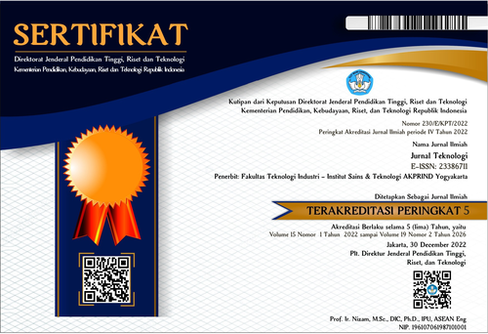Pengukuran Beban Kerja Fisik Dan Beban Kerja Mental Berbasis Ergonomi Terhadap Karyawan PT. Woneel Midas Leathers
DOI:
https://doi.org/10.34151/jurtek.v15i1.3979Keywords:
mental workload, physical workload, production targetAbstract
This research was conducted to determine how much physical workload and mental workload received by employees at PT. Woneel Midas Leathers, especially in the Quality Control (QC) department in carrying out their work. This research is a descriptive study, using a sample of 40 female employees who are the entire population of QC workers at PT. Woneel Midas Leathers. Data collection includes filling out the NASA-TLX questionnaire for mental workload analysis, and using employee physical data to calculate Body Mass Index (BMI) and pulse data calculated using the %CVL (Cardiovascular) method for physical workload analysis. The results of the calculation of the physical workload calculated using the %CVL (Cardiovascullar) method with an average physical workload of 31.62 employees are included in the "Required Improvement" classification. The NASA-TLX classification value of the average employee WWL that has been obtained is 81.48. This shows that the average value of mental workload received by employees is in the "High" category. Based on the results of calculations using the statistical regression method using SPSS software, the Sig value is obtained. of 0.441 which indicates that between the two variables, namely the physical workload has no effect on the mental workload. Likewise, the ideal body weight does not affect the mental workload conditions received by each employee.
Downloads
References
Achyana, M. (2016). Faktor-Faktor Yang Mempengaruhi Beban Kerja Room Attendant Di Grand Jatra Hotel Pekanbaru, 3(2), 1–12.
Kuswana, W. S. (2016). Ergonomi dan K3 (Kesehatan dan Keselamatan Kerja). Bandung: PT Remaja Rosdakarya
Mutia, M. (2016). Pengukuran Beban Kerja Fisiologis dan Psikologis pada Operator Pemetikan Teh dan Operator Produksi Teh Hijau di PT Mitra Kerinci. Jurnal Optimasi Sistem Industri, 13(1), 503.
Rizqiansyah, M. Z. A., Hanurawan, F., & Setiyowati, N. (2017). Hubungan Antara Beban Kerja Fisik Dan Beban Kerja Mental Berbasis Ergonomi Terhadap Tingkat Kejenuhan Kerja Pada Karyawan Pt Jasa Marga (Persero) Tbk Cabang Surabaya Gempol. Jurnal Sains Psikologi, 6(1), 37.
Simanjuntak, R. A., & Situmorang, A. D. (2010). Analsis Pengaruh Shift Kerja Terhadap Beban Kerja Mental. Jurnal Teknologi, 3, 53–60.
Tarwaka, P. (2015). Ergonomi Industri (Cetakan. 2). Surakarta: Harapan Press.
Wulandari, S. (2017). Analisis Beban Kerja Mental, Fisik serta Stres Kerja pada Perawat secara Ergonomi di RSUD Dr. Achmad Mochtar. JOM Fekon, 4(1), 954–966
Downloads
Published
How to Cite
Issue
Section
License
Copyright (c) 2022 Endang Widuri Asih, Widia Marselia, Cyrilla Indri Parwati, Arie Pohandry

This work is licensed under a Creative Commons Attribution 4.0 International License.
Jurnal Teknologi provides immediate open access to its content in order of making research freely available to the public to support a global exchange of knowledge. All articles published in this journal are free for everyone to read and download, under licence CC BY SA.
Benefits of open access for the author, include:
- Free access for all users worldwide.
- Authors retain copyright to their work.
- Increased visibility and readership.
- No spatial constraints.




















